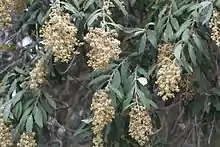| Tarchonanthus camphoratus | |
|---|---|
 | |
| Foliage and flower heads, Nature's Valley, South Africa | |
 | |
| Habit | |
| Scientific classification | |
| Kingdom: | Plantae |
| Clade: | Tracheophytes |
| Clade: | Angiosperms |
| Clade: | Eudicots |
| Clade: | Asterids |
| Order: | Asterales |
| Family: | Asteraceae |
| Genus: | Tarchonanthus |
| Species: | T. camphoratus |
| Binomial name | |
| Tarchonanthus camphoratus | |
| Synonyms[1] | |
| |
Tarchonanthus camphoratus (known as camphor bush for its scent, or leleshwa in Kenya), is a shrub or small tree, widespread in Africa south of the Sahel.
Description
The camphor bush can reach up to 6 meters in height. The twigs and younger stems are white-felted, as are the undersides of the leaves. The upper leaf surface is dark olive-green. Bruised leaves smell strongly of camphor. Tarchonanthus camphoratus is dioecious. Flowers are usually present from December to May (in South Africa), with cream colored panicles on a discoid head. Male flowering heads have several flowers whilst the female has only a few. The fruit is a dense and woolly achene.[2]
Cultivation and uses
Tarchonanthus camphoratus wood is fragrant, close-grained, attractive, durable and rich in aromatic oils. It is used as wood fuel and a source of charcoal.[3][4] It is also used as a traditional building material, in horticulture, and in tribal papermaking. Leleshwa is also a source of aromatic oils[5][6] used as fragrances. Its leaves are used by the Maasai to scent their homes and persons.
Medicinal use
Tarchonanthus camphoratus is used as a traditional remedy for respiratory illnesses.[7] The species has wide range of local uses, including dental hygiene.
Gallery
 Trunk and bark
Trunk and bark Wood
Wood
References
- ↑ The Plant List: A Working List of All Plant Species, retrieved 1 July 2016
- ↑ Hilliard, O.M. Compositae in Natal. University of Natal Press, 1977. pp. 110-112.
- ↑ Young, T.P. & C. Francombe (1991). "Growth and yield estimates in natural stands of leleshwa (Tarchonanthus camphoratus)". Forest Ecology and Management. 41 (3–4): 309–321. doi:10.1016/0378-1127(91)90111-8.
- ↑ Kennedy, A.D. (1998). "Coppicing of Tarchonanthus camphoratus (Compositae) as a source of sustainable fuel-wood production: an example from Laikipia Plateau, Kenya". African Journal of Ecology. 36: 148–158. doi:10.1046/j.1365-2028.1998.00115.x.
- ↑ Mwangi, J.W.; Achola, K.J.; et al. (1994). "Volatile constituents of the essential oil of Tarchonanthus camphoratus L.". Journal of Essential Oil Research. 6: 183–185. doi:10.1080/10412905.1994.9698351.
- ↑ Bishay, D.W.; Attia, A.A. & Fayed, M.A. (2002). "Flavones and a quaternary alkaloid from Tarchonanthus camphoratus L.". Bull. Pharm. Sci. Assiut Univ. 25 (1): 1–6. doi:10.21608/bfsa.2002.65503.
- ↑ "Tarchonantus Camphoratus Herba", Google Docs.